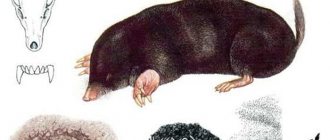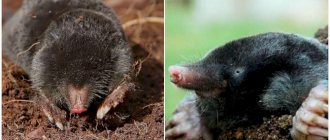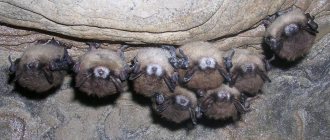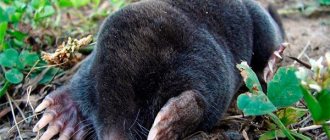Next you will learn:
- Do moles hibernate like many other animals, or is this a myth;
- How moles winter, and what helps them survive the cold season;
- Do moles store food for the winter and continue to dig under the snow in search of new food;
- Is it worth leaving mole protection on the site for the winter, or does it not make sense?
...And also a number of other interesting nuances regarding the wintering features of moles.
Winter is a very difficult period for moles - during the cold season, these animals have to mobilize all their resources in order to survive, so they carefully prepare for wintering. However, even despite this, in some years many moles die without surviving until spring.
For many gardeners and owners of a summer cottage, the question of how exactly a mole overwinters is of practical importance, allowing you to competently organize the protection of a garden or a resting garden from these animals - we will also talk about this a little later.
Kinds
There are currently more than 30 different species of moles. The main four types that are quite common are:
- Blind mole (small);
- Caucasian;
- Siberian;
- European.
Because they spend most of their time underground, they have very small eyes and ears that are almost entirely covered in fur. Their most distinctive feature is their powerful paddle-shaped front end with large, thick toenails that they use to dig their tunnels.
Let's take a closer look below:
- Do moths hibernate;
- What helps moles survive in the cold season;
- Are they able to collect supplies for the winter and continue to dig under the snow in search of new food?
We protect our possessions
Since moles are active in winter and their lifestyle remains almost unchanged, summer residents and gardeners are not happy with such a neighborhood.
What harm does this little animal cause:
- destroys beneficial earthworms in a state of suspended animation;
- underground passages violate the integrity of the garden;
- breaking through new passages, they cause damage to wintering plants, for example, garlic, onions, beets, etc.
In the cold season, under the snow, this activity is not noticeable, but it will become a big unpleasant surprise in the spring.
Therefore, in order to protect your garden from uninvited guests, it is recommended to leave ultrasonic or homemade repellers on all winter. In addition, it is worth keeping traps, nets and trenches against moles for the winter.
Video at home “What does a mole do in winter”
Owners of large plots of land on which crops are grown often have problems due to the appearance of moles. Since these animals complicate the growth of cultivated plants in summer and autumn, there is nothing to harm them in winter, but gardeners are interested in whether moles hibernate in winter. In this article we will provide information about how moles overwinter, how they hibernate, what they do in winter, what they eat. Contents
- 1 What is hibernation in moles
- 2 Video at home “What does a mole do in winter”
- 3 How he lives
- 4 What does it eat?
- 5 Video at home “Life activity of the common mole”
From the video you will find out what this animal does during the cold season.
From the video you will learn how this animal lives.
The myth about hibernation of moles
Many homeowners assume that moles hibernate and are not active during the winter months, but this is not true. Their main permanent tunnels and nesting burrows are dug deep underground below the frost line, allowing the mammals to remain active during the cold winter months. In winter, they stop digging surface tunnels in the soil as the ground freezes. Since people cannot see these surface tunnels, they believe that the moles are hibernating and are not causing damage to their lawns, gardens, or gardens.
In winter, moles do not hibernate because they cannot store fat on their bodies, since it is quite cold outside. Instead, they follow earthworms deep into the ground to stay warm and well fed during the cold winter months. Afterwards, they lie patiently waiting for the warm weather to return and appear like clockwork to continue its vicious cycle of wreaking havoc in yards and gardens everywhere.
To rid your garden of moles, you need to choose a specific method of fighting them. Before doing this, you should carefully read the various methods and know all their advantages and disadvantages. Some will choose to fight the invasion of these animals with store-bought tools. Someone will decide to use popular folk remedies that you can make yourself.
How moles winter: do cute animals hibernate?
The question of how moles overwinter and whether they hibernate is of interest to owners of summer cottages for good reason.
After all, knowing how moles overwinter, you can put an end to the tireless digger, who constantly makes his changes to the carefully thought-out plan of the landowner.
Mole in the snow
But to do this, he will have to find out whether hibernation occurs in moles, and if it occurs, then from what time.
About the features of the life cycle of moles
The belief that moles hibernate specifically during the winter months arose due to a false association with a bear: the animal supposedly goes into sleep for the entire winter, and is prevented from dying from cold and hunger by its fat reserves accumulated over the summer. This is an absolute fallacy.
Scientists who studied the question of how moles spend the winter in nature came to the conclusion: the animal almost never stops.
Mole on a snowy road
It digs all its life, but not at all because it enjoys it madly - it is driven forward by an insatiable hunger.
An animal that is not distinguished by either acute vision or hearing, on the surface of the earth becomes easy prey for predators, is forced to hide in underground passages all its life, only for a short period of time during the year surrendering to the power of the instinct of procreation. The rest of the time it is busy with survival.
You can also read our article: What does a mole eat at a summer cottage and in nature, an overview of the diet of a mole rat
How does a mole behave in winter?
The only way for a mole to stay alive and retain body heat is to constantly eat and move.
Mole tracks
The conviction that he lives a very comfortable life due to the abundance of various roots and roots in the ground is another myth.
Nutritional nature
The mole is a carnivore; it feeds on creatures leading an underground lifestyle:
- worms;
- snails;
- insects and their larvae.
And if you’re lucky, even small rodents too. But since his prey usually actively resists capture or has to be simply dug up, he is forced to constantly expand his empire.
The very process of crawling through holes, the need to squeeze through gorges takes a lot of strength from him.
Mole diet
Need I say how much energy is required to dig new tunnels, and what kind of fat reserves we can talk about here? Everything that can be eaten goes into muscular work, which does not stop either in winter or in summer.
The only difference is that in winter the ground temperature drops sharply, forcing the mole to eat and move even more so as not to die, numb from the cold.
Having finished with the topic of whether a mole sleeps in winter, we should also cover another, no less interesting question: at what depth does a mole hibernate? The general answer will be: where there is food.
Yes, worms go deep into the ground up to a meter for the winter - and the ever-hungry mole has to follow them. But only for a short time - the pressure of the deep layers of the earth is unbearable for a small animal, and besides, it needs air to breathe.
For this reason, he can sometimes be found right under a layer of snow, eating the carcass of a dead mouse, looking for prey among the fallen leaves, or he, busy with his usual business, may appear at the top of a fresh, not snow-covered molehill.
The main food horizon of the animal consists of depths ranging from the subsoil layer to about half a meter.
Does a mole sleep in winter?
The question of whether a mole is capable of hibernating also has a negative answer.
Of course, constant exhausting work requires rest, and the mole, of course, sleeps. But he doesn’t sleep for long, no more than an hour and a half, curled up like a cat, tucking his bare paws and snout under him in order to conserve body heat (for the same purpose, having previously cleaned and fluffed his fur coat).
Mole on the surface
But hunger and the growing cooling of the body lift the mole “out of bed” in the nesting chamber, sent out by scraps of its own fur, to again throw it in search of food. Quickly tired of hunting, the animal again climbs to where it is warmer and falls asleep, lying down to rest 5 to 6 times a day.
In the eternal darkness of underground labyrinths, time does not matter - only life is important, to save which the mole has to hunt and eat almost continuously, and sleep in between meals.
Should you protect your property from moles in winter?
After covering the question of how moles spend the winter (almost as actively as they spend the summer), it becomes clear that there is no season as such for them.
Therefore, measures to protect the site from small, ubiquitous beasts should be no weaker than in other seasons.
In this topic, another important nuance may arise related to the structure and fertility of the land in the country.
Since moles are not able to live in just any soil, a patch of it under a house can become a refuge not only for old-time diggers, but also become attractive to the animals living in the neighborhood.
Thus, the inaction of the owner can cause animals from all over the immediate area to move to the site; they will breed as many as the land can feed.
Therefore, despite the apparent decrease in mole activity in autumn, the fight against them should not be stopped throughout the year.
Here's a video where a summer resident-blogger conducted an experiment and drove moles away from his plot
As it turned out, the most effective way to get rid of moles is to catch them! All other methods simply do not give results. He used a supercat mole catcher as a tool to catch the mole.
Below is a diagram of how to install the Supercat mole trap!
Technology for using mole traps
Read more about the Supercat mole trap - Supercat Vole Trap mole trap from Swissinno or a cheap analog cat Fedor (Fedr)?
And those who don’t believe it and want to check whether the mole has fallen into hibernation can be advised to observe the condition of the site and life on it.
The appearance of fresh molehills when the level of snow cover is low, the unusual animation of a domestic cat, intensively, excitedly raking snow and clearly hunting - all this may be signs of increased activity of underground inhabitants.
Mole holes on the site in winter
And absolutely indisputable evidence of it will be the capture by a cat or dog (with the obligatory bringing into the house) of one of these creatures, which seems so harmful when it lives at depth - and so small and pathetic when it only takes up half the palm of an adult person .
Conclusion
The answer to the simple question of how moles overwinter can be unequivocal and short: it’s hard and hungry. Yes, they are not guilty that nature created them this way.
But a person, unlike an animal, chooses for himself:
- how should he live;
- where should he live?
And I would really not like such a small creature as a mole to be erased from the face of the earth by the cunning and fierce malice of his “elder brother”, directed at all living things.
And how one would like to hope that a way to get rid of moles without necessarily killing them will one day be found.
Video: Wildlife: Mole
Let's get to know the digger better
The mole is a representative of insectivorous mammals, adapted to a burrowing, underground lifestyle. Depending on the species, the body size of this animal varies from 5 to 20 cm.
A few words should be said about the peculiarity of his fur coat. The mole's pile is short, soft, grows straight and lies freely in different directions, which allows the little animal to move freely underground in any direction.
The animal sets up a nesting chamber at a depth of up to 2 meters and insulates it.
Habits of moles
Moles do not live alone, but settle on the site as a whole family, consisting of several adult moles and the younger generation. If you find one animal, know that there are at least a couple more of its relatives nearby.
Moles are active all year round and do not hibernate. Therefore, the fight against them must continue throughout the year. In addition, animals are awake almost around the clock, walking around their possessions and digging new tunnels in search of food, which they consume in huge quantities. During the day, animals eat an amount of insects that almost exceeds their own weight.
Mole holes are located in the surface fertile layer of the earth (at a depth of 5 to 20 cm), where the bulk of worms, beetles and larvae that make up the diet of animals live. Moles are not interested in plant food.
The mole does not let the earth pass through itself; it rake it to the side and pulls out all the excess. This is how molehills appear - dug up mounds of earth next to molehills. The animal easily and quickly restores a dented mole tunnel by lifting the earth that has fallen into the tunnel.
If you remove the earthen cap over the mole tunnel, the animal will burrow deeper or build a bypass tunnel.
Moles are strong and agile creatures. It is almost impossible to hold a caught animal in your hands. In any case, you can catch a mole only with thick gloves - it bites and scratches quite strongly and painfully, trying to escape from your hands.
Moles move on the ground at the speed of a fast human step - 5-7 km/h. They burrow into the ground even faster. Therefore, if a mole jumps out of a trap or trap, you have about half a minute to catch it.
Moles have poor eyesight, which is compensated by excellent sense of smell and hearing. Contrary to popular belief, moles are quite intelligent creatures and rarely fall into the same trap twice.
Are there any benefits to mole tunnels?
Moles dig tunnels and nest in the deep depths of the earth (they will not be visible on the surface of the earth). In addition, they also dig shallow tunnels beneath the surface of the earth on a daily basis as they search for earthworms and insects to feed on. Thanks to this, they rid the garden of pest larvae. When people see such tunnels, they immediately associate them with shrews.
Moles do not reuse these temporary tunnels and simply continually dig new ones every day in search of food. Unfortunately, this habit causes great damage to your lawn and garden. Since while digging a new tunnel, these cute animals harm the root system of vegetable and garden plants.
How moles winter
It turns out that these animals do not hibernate. Even in the coldest winters, the mole in nature is in a vigorous state - hunger is not a problem, as they say. Making passages under the snow, he looks for clusters of wintering insects, which make up his lunch. The mole also searches for prey underground, digging the soil at a depth where it is in an unfrozen state.
These rodents also make supplies for themselves. Collecting earthworms, which he is no longer able to eat in one sitting, the mole bites through their heads, thereby paralyzing the invertebrate. As necessary, the thrifty owner fills the stomach with food from his bins.
What does it eat?
In winter, the mole cannot hibernate, so it needs to eat normally in order to maintain the normal functioning of its body.
For an animal to feel full, it needs to consume at least 80-90 grams of food per day. Without food, an adult mole can live up to 18-19 hours, and babies even less. Therefore, these pests are constantly looking for a place where they can find food.
It is generally accepted that it is the feeling of hunger that increases the activity of the animal, both in the spring and with the onset of cold weather. Digging out a large number of underground passages, this mammal spends a lot of strength and energy.
As at any other time, the diet consists of earthworms, various insects, as well as their larvae, beetles, snails and similar living creatures.
A mouse or shrew can get into the wide branching system. They often use passages that were dug by a predator. If she finds herself in a dead end, she will become food for the mole. It can also eat rodents that have died from starvation, since these animals can also eat carrion.
Despite the big appetite of the burrowing animal, it is able to prepare food for itself for the winter. Earthworms are used primarily for harvesting. The mole bites off the head of the worm, and the back part remains lying in its tunnels. Sometimes separate rooms may be used to store supplies. Otherwise, throughout its entire system of underground passages there will be remains of worms, which the predator will eat if there is a shortage of food.
After conducting research, scientists carefully studied the approach of these animals in preparation for wintering. More than five hundred stored worms were discovered, which were found in the mole's nest or tunnels. Of course, this will not be enough for the animal to feed all winter, but it will make it much easier for him to survive during cold weather for some time, since it is difficult to find food in winter.
Does a mole sleep at all?
Of course he sleeps, because, like any other creature, he needs time to recuperate. But the regime of the underground inhabitant is not at all the same as what we are used to observing in other animals. Since the underground passages are dark, these animals have no “sense of time” - they absolutely do not care what time they go hunting or sleep.
Therefore, they sleep for an hour and a half at regular intervals, up to 6-7 times a day, comfortably sitting in their insulated nesting chamber. Moles live in the same chamber while feeding their offspring.
Naturally, the animal’s winter sleep is longer than in other seasons, but still the feeling of hunger drives it to dig new tunnels and look for food.
OUR READERS RECOMMEND!
To get rid of rodents, our readers recommend the Pest-Reject repeller
. The operation of the device is based on the technology of electromagnetic pulses and ultrasonic waves! Absolutely safe, environmentally friendly product for humans and pets. Read more here...
When is the best time of year to catch moles?
These animals can be captured at almost any time of year and in most weather conditions. There is no specific time when they are easier to catch. Moles dig the same way at any time of the year, but they tend to be more active during the spring, summer and fall. When moles are more active, they use their runs more often and therefore have a greater susceptibility to being caught in a set trap.
The most terrible enemy of a gluttonous mole is hunger. Lack of supplies is the main cause of death for these mammals in winter.
The main methods used to combat moles are:
- Tin can noisemaker;
- Plastic, glass bottles with an open neck;
- Ultrasound;
- Filling the tunnel with water;
- Ammonia, kerosene, castor beans;
- Net.
The myth of hibernation
Since in winter, despite their warm coats, moles are forced to go deeper, an erroneous stereotype has formed that they are sleeping.
There are several explanations for this opinion:
- The gardeners have harvested and think that the mole has nothing to eat, so he falls asleep. This is fundamentally wrong. These mammals are predators! Both damaged tubers and roots of garden plants are just “additional losses” as a result of these animals hunting for bugs and worms.
- Those who know that moles are carnivores believe that since with the onset of cold weather these small predators cannot find enough worms or insects, hibernation is their salvation from hunger.
- If a field or garden is covered with a sufficient layer of snow, then a person simply cannot see how the animal makes new moves.
Of course, the mole goes through very difficult times in winter. In order to survive in harsh conditions, he carefully prepares for wintering, thinks through what reserves to make for the cold period and mobilizes all resources.
However, in particularly cold years, not all wintering moles are able to survive until spring.
But frost is not very scary for these animals, because Mother Nature has awarded them with a warm coat that protects them from the cold underground.
The most terrible enemy of a voracious mole is hunger. Lack of supplies is the main reason for the death of these mammals in winter.
Ways to fight
The easiest way is to fill the mole holes with water. Of course, in this way you can remove the mole from the garden, but only for a couple of hours, until the mole digs a new tunnel next to the flooded one. The second method, more effective than the first, is to put pressure on the mole’s strong sense of smell and drive it out with the help of pungent odors.
We suggest you read: What does a vole eat: in a meadow, forest, steppe or taiga, is it a herbivore or an omnivore?
To do this, you can use kerosene, mothballs, castor oil and even rotten eggs, anything that gives off an unpleasant odor. For example, you can dilute kerosene in one hundred grams of hot water, wet a rag with it and plug all the mole holes that you can find with it.
But the most effective way to drive moles out of the area is with the help of special ultrasonic devices, which can be bought in specialized stores. The essence of the device is simple: it emits ultrasound, which is unpleasant to animals, which is why moles will be forced to leave the area within the shortest possible time. The only disadvantage of this method is its cost, because such devices are by no means cheap.
Why do moles create tunnels and hills?
Moles create tunnels for two purposes, traveling and feeding. Passing tunnels are pathways between feeding areas and the bottom. Feeding areas are usually marked by clusters of mounds and shallow tunnels. Their goal is to help the mole hunt for its main diet, worms. The mounds or "mole hills" are excess dirt that has been mined by the jetty to create these tunnels.
Pest or not?
Does it make sense to drive moles out of your area? Before answering this question, it is necessary to analyze the pros and cons of the appearance of moles on the site.
So, the advantages include:
- The fact that moles contribute to loosening and increased aeration of the soil cover.
- The fact that moles eat all the pests that can live in the gardener’s soil. All possible grasshoppers, mole crickets and even field mice are safely eaten by the mole.
But no matter how many advantages there are in the appearance of moles on the site, the disadvantages are much more serious:
- Moles dig up cultivated soil, thereby disturbing the integrity of the soil cover, which can lead to the death of plants planted in this soil.
- Moles eat worms in the area, which help loosen the soil.
- Moles, while moving, throw up infertile soil, worsening the future harvest.
- Various infections and diseases can be carried by moles and mice (mice, in some cases, can use mole passages to get to bushes, etc.).
These are not all the troubles that a mole can bring, and that is why it needs to be removed from the garden, fortunately, humanity has come up with a lot of ways to do this.
How to get rid of moles on your property forever. Even in winter
How to get rid of moles on the site as quickly as possible? This question is asked by many owners of suburban areas and vegetable gardens in the Leningrad region when they find their plot literally dug up length and breadth. And even in winter there is no peace from moles until the ground freezes sufficiently, and given the rather mild climate in the North-West region, moles can only go on vacation for a couple of weeks in January-February, when frosts reach 20°C.
Moles can appear on the site and in the garden even in winter
Here is clear evidence of how the moles worked on the site at the end of November , when the area had already been frozen for a couple of weeks and the first snow had fallen. Such a terrifying picture was discovered by the owner of the site when he arrived at his house.
In addition to numerous already powdered holes in the area, there were also very fresh traces of the presence of moles, indicating their activity, so it was impossible to hesitate, but to begin the fight against moles . The owner of the site was not at a loss, but immediately contacted several SES services, after which he decided to call specialists from SES Control.
Within a couple of hours, our disinfector began assessing the consequences of the mole invasion and developing a plan to ensure that the destruction of moles on the site was as effective and quick as possible.
How to get rid of moles on the site
The fight against moles in the area has been going on for many years, and without false modesty we would like to note that SES Control specialists have succeeded quite well in this matter. We have accumulated extensive experience in deratization of moles in areas of varying sizes and complexity, and the arsenal of methods for exterminating moles includes all kinds of methods for successfully combating rodents, both with the help of the most modern poisoned baits and mechanical mole traps.
We are ready to come to your site all year round and save your land and supplies from rodents, protect your garden from moles even in winter !
Professional deratization in St. Petersburg and the Leningrad region. Fighting moles, rats and mice
Also, with the onset of cold weather, rats and mice begin to strive for warmth, gnawing through numerous passages and canals in country houses in search of food and shelter for the winter, so it is imperative to take care of protecting at least your home from rodents for the winter. To do this, it is enough to carry out preventive deratization, or buy special poisoned baits for rats and mice in our disinfectant store and arrange them according to the instructions.
You can contact us for qualified help in matters of rodent control, as well as receive free consultations on how to effectively resolve the issue specifically in your case and on your site. Contact the professionals - we will definitely help you!
Habitat
The habitat of moles is the west of Russia, Siberia and the east of the Urals, or rather, their forests and forest-steppe zones. They choose to live in regions with moist soils that are easy to dig and are rich in what moles eat in the forest and in the areas bordering it. The majority of animals lead an underground lifestyle, making tunnels.
Some animals prefer a terrestrial lifestyle, which allows them to find food without much difficulty. True, due to the structural features of the front legs, designed for tearing up the soil, moles have to move only by crawling on land. Deep twilight and night are the hours when these animals are active.
In the steppe and taiga expanses there is not a sufficient amount of what moles feed on in the forest (due to acidic and dry soils). However, they are occasionally found in these zones, colonizing water meadows and river floodplains covered with bushes.
Hunger strike is fatal for a mole
How long a mole lives is influenced by the animal’s diet. It turns out that he digests food within four hours, so he needs to refuel often. Even a short fast of fourteen to seventeen hours can be fatal.
Who knows what moles eat in nature? Many believe that this animal loves root vegetables, and therefore is a pest of gardens and vegetable gardens, destroying crops. In fact, moles are predators. Their diet consists mainly of invertebrates: worms, snails, slugs, insect larvae and pupae, woodlice, and millipedes. In one feeding, a mole can eat twenty-two grams of food, and in a day - up to sixty grams.
To catch earthworms, moles dig special feeding tunnels underground and set traps in them. Earthworms, attracted by the special musk of these insectivorous “hunters” - an odorous bait, crawl on the scent and become prey for moles.
It happens that a mole can eat a mouse, lizard or frog. But this can only happen if the small animal is immobilized for some reason.
So you shouldn’t say that moles ate the entire harvest in the garden or country house. Rather, the harm from them is due to the dug underground passages, which, of course, destroy many plants, and because of the earthen slides that appear during the digging process.
Reproduction
The animals mate in the first days of spring. Offspring appear once a year, not earlier than April-June. In a litter, 3-9 blind and naked cubs are found. The young make quiet sounds similar to a chicken squeak. At first, the cubs are friendly, but over time, aggressive fights arise in the brood.
Month-old moles are difficult to distinguish from adult moles. At this age, the animals begin to leave their mother’s habitat and build their own highways. During the migration period, if necessary, they swim across small rivers.
Feeding the Cubs
The mating season for moles begins in April and lasts until the end of May. Pregnancy lasts about 30 days. The younger generation is born in June-July. Very rarely does a female give birth to two litters in one season. She gives birth to about 9 babies at one time.
In the first week of their existence, moles weigh no more than 5 g, are blind, naked, toothless, and absolutely helpless. For 3 weeks, the diet is exclusively milk. The female carefully looks after them, takes care of them, and protects them from enemies. At the end of the month, young moles begin to eat worms and larvae, and after 60 days they reach the size of an adult animal and are capable of strangling a mouse, lizard, or snake.
Source











